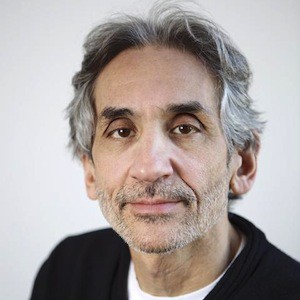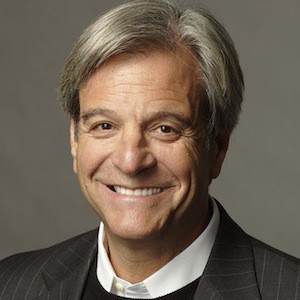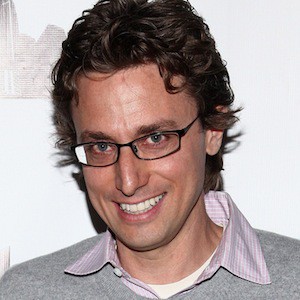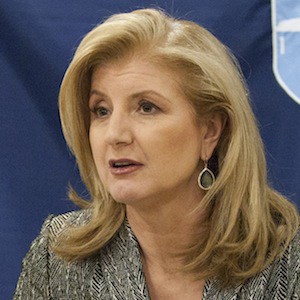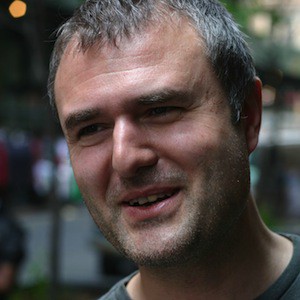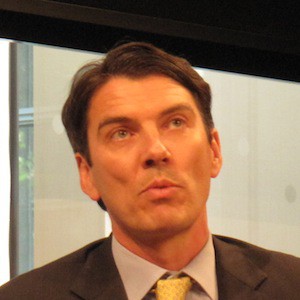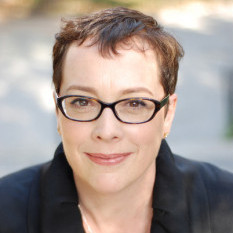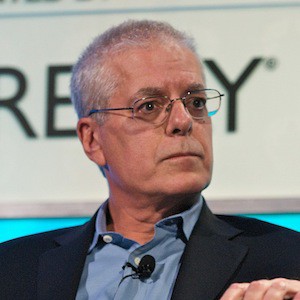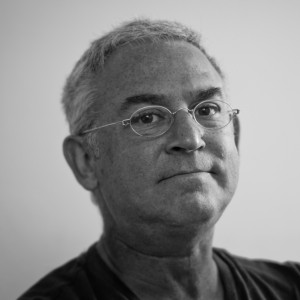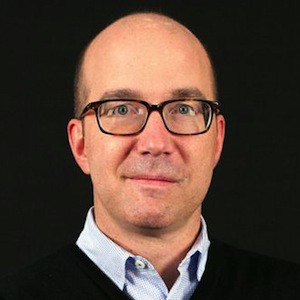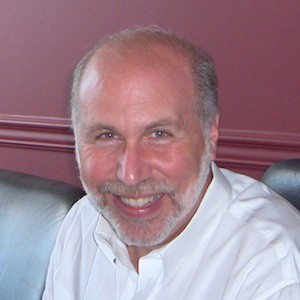Martin Nisenholtz: Henry Blodget, New York City, March 14, 2013. Let’s start with when you first…I’ll give you a choice. You can start in one of two places. You can start with when you first met the Internet, or you can start with when you first realized that the Web was going to have a very profound impact on publishing. It may be the same moment, it may not, but let me start there.
Henry Blodget: Just give you a brief background on me. When I graduated from school or shortly thereafter, figured I was going to go into journalism. At that point, journalism was print, TV…
John Huey: What year was that?
Henry: That was 1988 when I left school. Spent a year teaching and writing a book and then was figuring out what I was going to do. I figured I would be an editor at a magazine. I’m not sure why. That was just the thing to do. Freelanced in New York for a while, a bunch of magazines. Actually, I ended up freelancing at CNN, too, so got a picture of TV, and then ultimately went to Wall Street for 10 years, but had a good basis of freelance in the media at the time, which was basically print and TV.
On Wall Street, relatively quickly, that was when Netscape came along, the IPO. Everyone got incredibly excited about the Internet. Huge action. I was one of the first people on my office floor to get a browser. The second thing I got was PointCast.
Suddenly, everything is changing right away in front of your eyes. You didn’t know where it was going to go, but it was going to be a big change. That was the year when Bezos jumped in his Honda and drove across the country, figuring that e-commerce is growing at 1,000 percent a month or whatever it was, going to be a big opportunity.
It was clear in those days that the Internet was going to revolutionize industries. People had very little idea about exactly what it was going to do. Most of the companies that came out in the 1990s were companies that really took advantage of what was different about the Internet. You also had a lot of traditional media executives looking at it and saying it’s going to be just like TV or it’s going to be just like print. They would transplant the TV or the print product. Didn’t work.
Then we saw the same thing that has happened in other media as they’ve came along. Basically, there’s the jamming the square peg in the round hole for a while.
Then the journalism perspective. I think people really started to figure it out about 5 to 10 years in. It was really 2000 to 2005 that you saw really new models of journalism start to emerge. Now, I feel like they’re hitting their stride.
Martin: What were those new models?
Henry: If you look at the range of different kinds of companies that have been successful, you can look at Matt Drudge, who started in the middle of 1990s. He is still doing something that takes full advantage of the new medium and does not replicate any of the old media. Internet is a medium that knocked down all geographical barriers. There’s no longer a way to put a case around content and control it the way you can in TV or in print. You’re not limited in terms of time. You’re not limited in terms of the number of sources of information that you can reach.
What Matt Drudge did was say, “I’m just going to see the whole world through one page. People are going to come to that page. They’re going to get what they got in all other media, which was a particular perspective on the world.” That’s the one end.
The other end was Gawker Media, which was producing its own original content, but it was a very different type of content than what was being produced in print or in TV.
In the middle was Huffington Post, which was doing a little bit of both. There was lot of aggregation, there was original content and so forth.
What we’re doing at Business Insider is a blend of those. We’re using all of those different techniques, but what every single one of those does that’s been successful is, it takes full advantage of the Internet. It’s not bringing a print model or a TV model to the Web. It’s actually saying, “What can we do with a fully interactive medium?”
Martin: Let’s stay on your bar. You spent 10 years on Wall Street. You then decide to start Business Insider? What made you decide to…?
Henry: A little bit of time between. I was in the Internet and was covering the industry. The most successful companies in the 1990s like Yahoo and eBay and Amazon were taking advantage of megatrends in commerce and so forth. Ultimately, some of those companies have died. Some of the new models have been reinvented. If you look at the most successful media company in history, it’s Google.
What does Google produce? What is the media? It’s search results. That’s what they produce. It turns out a lot of the conceptions that media had before that, which was what you want to do is capture a reader or viewer and hold them on your property. That’s the way to make money over time.
Google exploded all of that. Basically, what Google showed us was what you want to do is actually find them on their way somewhere and help them get there. That is the single most valuable media opportunity there is on the Web.
Google did that. It’s why it’s so incredibly valuable and successful. It’s swallowing up all advertising dollars from everywhere. Now, we’re getting into the next level of media like news and the news industry is reinventing itself.
The opportunity that I saw looking at Huffington Post, TechCrunch, and many of these other early next generation publications was there’s something new here. It is like coming into television journalism in the beginning, when people effectively read newspaper stories.
Then they figured out, wait, pictures are so much better at telling stories. Let’s use those and let’s have the host concept completely different than a newspaper. We figured that the digital opportunity would be radically different as well and it’s turned out to be. In fact having a new model…
[crosstalk]
John: What year did you actually start Insider?
Henry: 2007.
John: It’s in its sixth year. Can you tell us how and exactly what you did and what you were thinking?
Henry: When we started, it was three of us and a loading dock. We were focused on technology. The original conception was we’ll focus on New York Technology.
Martin: I think it was called Silicon Alley.
Henry: That’s right, Silicon Alley Insider. We were going to focus on New York technology. What happened was the first day half the traffic came from California. We immediately noticed that the Apple story was much better read than the story about the local New York start up. We said, “Why are we focusing just on New York? Let’s focus on technology.” I had a background in that. Obviously, it was easy for me to do.
We did that. We broadened. Then within sixth months, we realized there ought to be other publications like this that are serving other industries. The natural one for me was Wall Street, because I knew that well.
We originally thought that we were going to build a network of sites, the way Gawker has with each site focused on a different industry. We launched the Wall Street one. That began to work very well, but it didn’t make sense to have a separate brand.
Ultimately, we realized that in fact you could have a single brand that all of these are encapsulated under. After a year, we decided to start Business Insider. We basically just folded them all into that and we’ve been building that since.
Martin: But you think of it as a brand, not a network?
Henry: Ultimately, if you look at what the Internet does, and this was true in commerce as well, the big insight that Jeff Bezos had at Amazon was every other kind of retailer, physical world, any physical world retailer, even a catalog retailer, is very much limited in terms of its floor space or warehouse space. They either have to be a specialist. They go very deep into a category or they have to be super broad and an inch deep like Walmart. There are two models. The insight with Amazon is you could be both. You could be both infinitely deep in a particular category and then you could go infinitely broad. It’s exactly the same in news.
The New York Times, for example, has chosen to pretty much stick to its knitting, in terms of what it has done in the paper, when it looks at the breadth of what it is doing in terms of producing news.
There is no reason that over time the New York Times can’t quadruple the size of its newsroom and become a completely global organization. With one central entrance point, which is the New York Times, you can have an infinite amount of content produced behind that.
What we’re seeing right now, what I’m seeing right now in the news business is actually there’s tremendous overcapacity and a cacophony of different brands and organizations trying to adjust to it.
I think over the next 10 to 20 years, you’ll see a lot of consolidation. Ultimately, you’ll have a few big, global, news providers, where you can be both incredibly deep and incredibly broad.
John: Just a side question on that is something that obviously you’ve thought a lot about. Do you think you could be local in that context, too?
Henry: I think so. I think the key question on local is what brand a local community is going to rally around. I think there is tremendous affinity for the brand that’s been in the community for a long time. People are used to going to that. The idea of starting a single brand and saying we’re going to go into every local community and become the brand that everyone rallies around, that is a tremendously tough challenge.
John: Yeah, so that is what Tim [Armstrong at AOL] is trying to do with that?
Henry: That’s right. It’s a new brand.
John: It’s a spin on what you’re saying about broad deep. He’s trying to do essentially what you just said, but it isn’t quite [inaudible].
Henry: That’s right. Part of the challenge there is he’s trying to build it by building a macro first, then parachuting one or two people into a particular community. Then replicating that 40 times or in his case, 800 times across the country. That is very difficult. I think the way that the local news organizations of the future will be built is they may well be built from the existing newspapers that are there. They will have to be much more lean than the current ones, because they just simply will not have as much revenue to play with.
As we found, you can be vastly more efficient if you start to tell stories in a native digital format. It’s very hard to come in and say we’re just going to produce a newspaper and put it online. That’s very hard.
Just as TV is not producing a newspaper, if you think about it digitally you can be vastly more efficient.
Martin: Let’s talk about that for a second. You had a little interchange on Twitter, maybe 10 days ago with Jeff Jarvis, where you were talking about eating spinach. I think your view is you’ve got to be fairly entertaining to be…That’s at least the view I took. From an editorial perspective, what does that suggest? Does it suggest that institutions like the Times and others are not that the Times isn’t entertaining just writing for a different medium and need to be changing? What’s the takeaway from that in your view?
Henry: I think there’s a big argument right now about what’s going on in the news business. There are two big differences of opinion. One is that news is dying. The world is going to go to Hell in a hand basket. Who is going to do the hard reporting? Newspapers are caving in. How is the world going to police itself? That’s one. The other is what’s actually happening is that the amount of news that’s being created has been increased by a hundredfold over the last five years. People are absolutely drowning in it. That’s the one I subscribe to.
You’ve got anybody with an opinion can Tweet, they can blog, or they could go online. Any media organization says anything that somebody disagrees with, they immediately publish right to the Web. They’re as much in the conversation as the newspaper.
Effectively, what we’ve gone to is the old world through 1995, media organizations were the equivalent of a hydrant in the desert. They controlled the vital information flow. They had tremendous power because they were the gateway.
Now, we are a hydrant in an ocean. Media organizations are often still coming at it from the point of view is, “Wait, we get to choose what’s important.” People should consume it because we say it’s important.
The point that I’m making is there is so much out there to consume right now that you actually have to build something that people like. People do not want to have to eat spinach because it’s good for them. They simply won’t. There are too many options.
You got to make the spinach taste good, so that was the discussion I was having with Jeff Jarvis. I do feel in a lot of traditional media organizations now there still is a sense of entitlement, which is, “I thought a story was important. I worked on it for a long time. People should read it.”
Maybe they should in some perfect universe, but the fact is we all have jobs, we’re busy. Maybe we didn’t get time to read it. Maybe it was too long. Maybe it wasn’t as important as the reporter or the publication cited.
I think the reader has a vote in that. You got to make readers want to read it.
Martin: You think BuzzFeed is out…It’s a race to the [laughs] candy. It’s bad metaphor, but you know what I’m saying.
Henry: I think there are different things that are going on. I think that from the beginning media organizations have sold different audiences. The audience that likes to look at cute puppy pictures, which is incredibly huge, is a different audience than the Economist audience. BuzzFeeds insight. It was a very important insight that there is a lot of crossover there.
In fact, you don’t need a separate Economist and Cosmo magazine anymore. It can be under one brand. People could say, “This is the site whose tone and voice I relate to. I’m happy to look at puppy pictures next to the analysis of foreign policy,” or what have you. You can hang them all under the same structure.
That was their insight and worked incredibly well. There’s a big difference between that and having a newsroom like the New York Times newsroom, which is just 100 years of history, expertise, and incredible experts in a particular industry.
When I look at the New York Times, I think that the organization is going to have to continue to change radically. The idea that nobody cares about serious journalism anymore is crazy. They absolutely care. It’s just you’ve got news organizations coming at it and figuring out a model that supports that with other things.
By the way, you’ve got a television, the big hit show “Walking Dead” pays for everything else that AMC does. That model in the media industry of having a popular thing pay for the love projects or the important stuff has been traditionally true forever.
John: Would you mind just walking us through your business model? What it was when you started? Where it’s come in six years? How you think it can grow and what it could become?
Henry: Sure. When we started, we where three people in a loading dock. We started publishing. We said, “What do our readers like?” We published more of what they like. We published less of what they didn’t like. We knew relatively early that we were going to have to be supported by advertising. That was the goal, so we continued to build with that. We initially partnered with a third party reseller of advertising. We were part of their network, which is a model that works very effectively online. That helped us grow for the first three years at a very nice rate.
About three years in, we realized to get to the scale we wanted to get to, we had to build our own sales force.
John: What was the percentage of…It was mostly original, right?
Henry: Almost everything that we produce, up until relatively recently, has been original.
John: Great news. You have your own stories.
Henry: Great news. We build on other people’s stories all the time. When the New York Times reports an excellent story, we will go through it often and pull out a detail or two.
John: Your theory was that you were going to…Your stories were going to be a little smarter, a little more knowing, a little more point of view, and always fresh.
Henry: The theory was there are now a million points of news creation, effectively. Having somebody watching that world go by for you and pulling it into one place is valuable as long as you do it in an intelligent way. You don’t waste people’s time. Our hope was we can pull it together and then we can add some value to it. The moment it happens and is reported it’s no longer news. The next question is what does it mean?
John: Now you have a mix of what, commentary, reporting?
Henry: Features, lots of visuals. This is one of the things… [crosstalk]
John: Yeah, I read it so I know what… [crosstalk]
Martin: You brought some of the analyst perspective as well. Some of your best stuff is…
John: I was going to say, you asked about entertaining. Henry was entertaining when he was on Wall Street… [laughter]
Henry: To my detriment.
John: …which isn’t always that easy.
Henry: No, it’s interesting. When we started it was very much…It was almost like Wall Street research, a lot of analysis. What we realized is there is a small, influential, and very passionate group of people who love that, but not enough to make a media business. To make a media business, you’ve got to have that plus the personalities and the fun stuff. It’s the same thing as the New York Times.
John: Then you get your own sales force.
Henry: We get our own sales force, so that has helped us really grow.
John: What year are we in now?
Henry: ’04 and ’05. The last couple of years we have our own sales force.
John: How many employees in ’04 and ’05?
Henry: Now we’re 100, so we’ve grown from 3 to 100 over five and a half years.
Martin: How many employees…
Henry: I’m sorry.
Martin: …for sales?
Henry: Employees. Sales force is about 20.
John: Mostly in New York or all over?
Henry: Most of our employees are in New York. We have a couple of sales offices and newsrooms.
Martin: I’m asking everybody this question, but programmatic. This is an advertiser supported business for the most part. You do some conferences, which we should talk about, but tough now, less tough? What’s the affect of programmatic on your business? What do you think is going to happen over the long term?
Henry: For us, right now, it’s an opportunity, because we have basically two different types of advertising that we’re selling now. One is the big custom campaigns that we sell to the big 100 200 clients, global advertisers. Those are premium campaigns. They often have a custom part of them. That is what the sales force is selling. Then there are the commodity [banner] ads that most sites use to fill out the advertising units. What programmatic has allowed us to do is now raise the value of those a lot, so it’s helping us.
Industry wide, what you’re going to see is the programmatics or the automated buying and more efficient buying is going to drive down pricing for advertising. That is OK for us, because we have built the model to be able to do fine on ad rates that are considerably below the current average across the industry.
It’s going to continue to put a lot of pressure on traditional media organizations that are still trying to sustain a print cross structure or a TV cross structure and translate that online. It will not sustain that.
The good news is it will sustain a native digital newsroom. What it should do is allow us to just get much more efficient in using the ad space.
Martin: You don’t have any plans to charge for the service. You think that would be a mistake, I take it.
Henry: Like a pay wall?
Martin: Well, a pay wall, a metered model. Something.
Henry: I should think we will. What we’ve done now is we’ve launched a research product that builds on our tech expertise and that is designed to be sold to industry executives in recovering the mobile industry. We will continue to expand that well. That is what I would describe almost as like a high end journalism product, very focused on a particular industry. That’s doing well. That will definitely help us.
Martin: That one was going to teach with like a Forrester Research or GigaOm or something like that.
Henry: It’s much more akin to Om at GigaOM than it is to Forrester. Forrester is a multi thousand dollar subscription consulting and so forth. There is no question. You see this from Bloomberg to Politico to other high end news and information services. People in business will pay for insight and information.
John: Let’s continue with that. Go through that list. Give us the complete list with Politico.
Henry: Reuters, Bloomberg, Politico, and all manner of data providers to Wall Street or different industries. You see again and again GigaOM is doing it in technology. Most industries will have different service providers that sell a high end subscription service that helps people do their jobs better. That’s our goal in that business and that is going to continue forever.
John: You’ll go into dual and stream income pretty soon?
Henry: Yes. It’s becoming meaningful now, which is great. I do think, to your question to the main site, because we serve a business category. If you look across the spectrum from Financial Times, they have a whole bunch of different subscriptions to the Wall Street Journal, which I think has a $400 million digital business of which $200 million is subscriptions.
There’s no question that people will pay for a good business oriented product. The question is, what does it look like? Is it just you get bonus material? Is it a meter? Is it a wall? We don’t know, but we definitely do have a very passionate group of people who are on the site all the time.
If we can figure out a good way to give them more of what they want and charge a very small reasonable price for it, I think that model works and it will be important.
[interruption]
John: I was just going to ask, what is at the end of the first year the size of the audience and today the size of the audience?
Henry: I don’t remember exactly.
John: Roughly.
Henry: I would say the first day it was 2,000 people, which was like, “Yeah, 2,000 people!” Then it went down for two weeks, so we were like, “1,000 people. Not so good.” Then it bottomed and then it started going up. After the first year, we were at about one million a month. It has grown very steadily over the past five years to about 25 million a month now. That’s on our internal. Those are Google Analytics. What does that translate into in terms of people? It’s 10 million people on desktops in the US. There is another bunch on mobile and then there’s a big population outside of the US.
John: There are a lot of people at work, probably?
Henry: There’s no question that our main audience for the life of the company has been at work. You see the primetime during the day peeks at about 12:00 to 1:00 East Coast time. That’s when the West Coast comes on. People like to check it early in the morning. We’re designing the product to be accessible from work. You can read an article, you go back to work, and so forth. That’s one of the advantages that we’ve had. Interestingly, in the last couple of years with the rise of mobile, the day is getting extended. It’s now really 18 hours, where we see heavy mobile during the commute in the morning, heavy mobile during the commute at night, and then at night during bedtime, people in bed with tablets. The day is definitely getting extended.
John: That’s sad, isn’t it?
Henry: No, it’s happy. We’re thrilled about it. As soon as we can figure out a way to get you while you’re dreaming, we’re golden.
Martin: You describe this world expanding and contracting with some big players. What do they look like and what do economics look like in those? Would you call them news organizations or would you call them media?
Henry: I would absolutely call them news organizations. They may well be bolted onto other big organizations like a Google, for example, or Bloomberg where $6 billion of cash flow is coming every year from Wall Street. Why not bolt on a $500 million news organization as a rounding error? They may be married to those, but I do think that they will work economically. I think that over the next 20 years, 10 to 20 years, there will be some big digital news brands that are built, that have certainly hundreds of millions of dollars of revenue, and probably billions of dollars of revenue.
What do I think they’ll look like? I think they will look like we look. To put it in context, we have about 50 people in the newsroom. Our site is about half the size of the Wall Street Journal. The Wall Street Journal has about 1,700 people in their newsroom.
The reason we’re efficient relative to them in terms of people, is that we focus just on this medium and we’re creating content just for the medium. I think that what you’re going to see is over the next 10 to 20 years, organizations like ours will continue to grow.
I don’t whether it will be us. I don’t know whether we’ll be part of somebody else or we will decide to bring in others or what have you. I think our newsroom could grow to 200, 300, 400 people around the world and ultimately be vastly larger than the digital organizations of sites out there now.
John: Business Insider could end up being a buyer or a seller?
Henry: Yes. If you look at what I would describe from a business perspective as leverage points in the business, sales is a huge leverage point. It is very expensive and time consuming to build a sales force. Once you are calling on a big client or clients, that sales person can sell a small deal or they could sell a $20 million global deal. It’s the same cost to do it. What we want in that is scale. It’s the same thing with technology. We have a tech team that’s working very hard to build from the ground up a great contact management system and site, and so forth.
Lots of features associated with that. It’s different than we had five years ago and that’s a real competitive advantage for us. That content management system could easily be spread over 10 times as many newsroom folks and the cost of running the site. Both technology and sales, there’s a big leverage point.
Then just in terms of digital journalism. The consumption of news, the gathering of news, and the packaging of news, there’s a lot of leverage there.
Unlike television and print, both of those are limited by either space or time. TV, there are only 24 hours in a day. That’s all you can pack into a network no matter what. New York Times can only be so thick, even if you got the ads because you can’t go in there digitally, either of those barriers.
What that says to me is that the news organizations of the future are going to be much larger in terms of global audience than any of the existing ones now, because there are none of those barriers.
In terms of timeframe, what was surprising to me, a couple of years ago, I went back and looked at CNN, which revolutionized cable news. I found that in the very early ’80s, it was 10 years before anybody had even heard of them, they were basically broadcasting in a closet until the first Gulf War.
Then people suddenly became aware of them. Then they became a household name. Now we’re 33 years into CNN or 30 years into CNN. That’s how long it takes to build a global news organization. I think the same thing is going to happen digitally.
I don’t know whether it will be BuzzFeed or Huffington Post. I don’t know whether it will be a retooled New York Times or Wall Street Journal, where you really embrace digital, or whether it will be somebody new.
I think you will, in 10 to 20 years, have big digital news brands that are fundamentally different than the brands we have now.
Martin: The chest beating of all on how do we support serious stuff [inaudible] it was. Does that scale support a Baghdad bureau? Does that support the things that people worry are going to get lost in this transition?
Henry: Without question or it supports what the Baghdad bureau is turning up. Twitter, Facebook, and blogs, just an incredible new mechanism for unlocking information. We see that all the time. You can do things. You do not have to have a reporter on the ground, necessarily, to learn a huge amount about what’s going on. Citizens are contributing to global knowledge.
I don’t know whether it’s going to make sense for the New York Times to have a Baghdad bureau. What I’m very confident about is that the world will continue to be vastly better informed than it ever has been before.
I think even with the pressure on newspapers, the world is vastly better informed than it ever has been. We’re going to digital.
What we found is, when we started with the three of us, we had to come in early in the morning. Write frantically all day just to survive. Go home, eat dinner, and get online because something might happen. Plug in again and go.
Now that we have 50 people in the newsroom, we actually have the ability to do a lot more projects that look like much more traditional print or TV journalism. Where we can send a reporter to Canada to look at the tar sands, take a lot of pictures, and come back.
There are things that we can actually do with that that you can’t do in either print or TV, such as create wonderful photojournalism essays that really describe what’s going on. Couldn’t do that before.
I think there’s a native form of journalism that is developing digitally that is every bit as powerful as print or TV. It doesn’t look like them. If you’re looking at from their perspective, you would say, “That’s not quite what we do,” but tremendously powerful. Readers love it. It communicates a huge amount of information. Point being that the bigger we get, the more we have resources to do things like that.
I think what people forget when they look at the New York Times is, the New York Times has been at it for 100 years, They had a lot of profit to work with. Maybe they’re less profitable going forward, but they still have this wonderful newsroom with 1,000 people in it. Even if the paper died tomorrow, they would still have $200 million to play with in the newsroom, or at least $100 million. I don’t know what the numbers are, but it would be very big and powerful and could do a lot.
I think the hand wringing is completely misplaced.
John: To that point, is Business Insider profitable?
Henry: Shockingly, this quarter, surprisingly, we are. We didn’t expect to be. Basically, the way we’ve run the business every year has been…We have raised a little bit of money. We’ve invested, so we’re losing money with the idea that that would enable us to get bigger faster. In 2010, for the first time, we turned profitable. Very, very tiny profit. Then we immediately raised some more money and lost money in 2011 and 2012 again. This quarter we’re back to profitability, so what do we do? We immediately decide to spend more money. I think what we’ve done is that we’ve gotten comfortable if the model works.
At any point, we could say, “Now, we’re going to simply throttle back on the growth.”
John: Make money.
Henry: I personally am not running the organization to make money. There are other businesses that I think you could go into if the goal was the bottom line. I want to produce a product that our readers love that is self sustaining. The goal was not to have to bolt it onto an entertainment business or a soda business or anything else, but actually make it…
John: Or buy Time Warner.
Henry: Exactly. It was to produce it and make it self sustaining. I think we’re there, and I think we’re going to continue to invest.
John: To your point about the hand wringing is over exaggerated. One thing I’ve been telling people when they talk about that. It’s never been harder to get away with something than it is right now. Whatever it is you’re doing, you’re not likely to get away with it. But then I try to put this…You seem to be in this frame of mind. Let’s take something like the civil rights movement and say that you didn’t have strong television networks and newspapers committed to a long haul and physical courage and endangerment and all that. Say you didn’t have that, but everybody back then had smartphones and Twitter. Would we still have gotten through that with positive results? I don’t know.
Henry: The idea that you’re not going to have any organizations that have the wherewithal to put people in harm’s way if they want to be there or to invest a lot in it I think it’s just crazy. You look at it now. Let’s just take Bloomberg. There’s money everywhere! Just oceans of money!
John: They put people everywhere.
Henry: They’re everywhere.
John: What they don’t have is an audience. They have a brand. They have revenue.
Henry: That’s right. If they discover something important, it’s going to get out there in the world. There’s no question about that. Then you’ve got the TV organizations. You know when I realized that TV was not in fact in trouble, which I had been thinking it might be? When I went on the “Today Show” and I realized that they had full time employees, one of whom does nothing but steam the lint off your suit before you run on. I said, “TV’s in fine shape!” [laughs]
John: They have a half billion dollar revenue for the Today Show.
Henry: Fox News is making $750 million a year. There’s so much news gathering…
John: CNN makes 600 [million].
Henry: Exactly. Everyone’s telling you about how terrible. CNN’s going down the tubes!
John: Still making $600 million.
Henry: We are awash in news gathering capacity. What the Internet’s going to do, it’s going to make it more efficient. The digital model’s going to be different. But TV’s not going away, print is not going away. And now you have the ability for anybody anywhere in the world to publish information instantly that will be immediately seized upon by, in almost every case that I can imagine, an interest group that is very passionate about that thing. It will get brought to other people’s attention. I think we’re in great shape in terms of that.
Martin: I want to actually go from the large to the fairly small and mundane here for just a second. We had a chat with Nick Denton. He showed us it’s public, so you can see it yourself if you go to [inaudible 35:04] a new kind of comment. Not just comment, but really bridging. On the Times but I’d say even more so on Business Insider, the comments are just…it is a problem area. There are all sorts of… Do you think about that at all? Do you think what he’s doing makes sense? Do you think you’re going to adopt something like that?
Henry: I think about it a lot. Early on, when we were really focused on technology and technology analysis of businesses and so forth, we did have lots of very intelligent commenters coming in. We still do, but now they’re often drowned in people fighting back and forth and so forth. The issue for us has been how much effort are you going to put into moderating it. Is there a way to automate that? The answer is that the folks where it’s working…There are technology interfaces that you can get. There are reward systems. You have ways of banishing people who are being rude. That’s an area that we definitely want to focus on.
What I didn’t fully appreciate when we first started the site is that the vast majority of the readers are just reading. They’re not commenting. There’s a group that wants to comment. It’s wonderful to be able to cultivate them, especially when they have something intelligent to say or they’re funny or what have you. That’s what we want to focus on doing that.
Even just with the production of the news and storage, you’re reaching the vast majority of your audience, who is not paying any attention to the comments. In general, people pay too much attention to the comments, but it’s definitely an area where we can improve a lot.
John: I really enjoyed the evangelical quality of this interview.
Henry: Digital works! News is alive and well! [laughs]
John: I’m feeling much better.
Henry: You’ll feel great!

